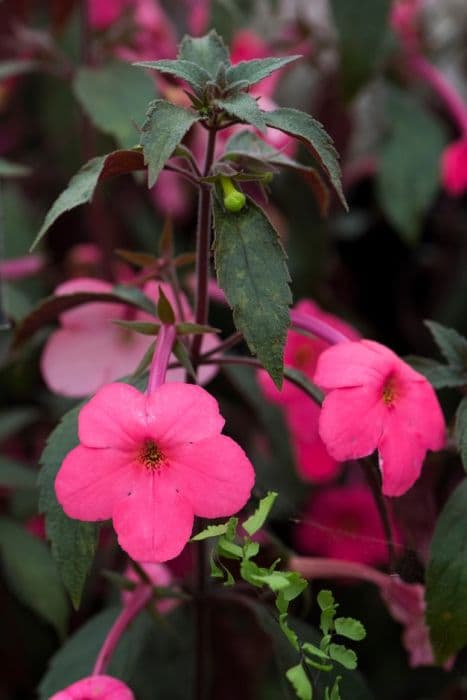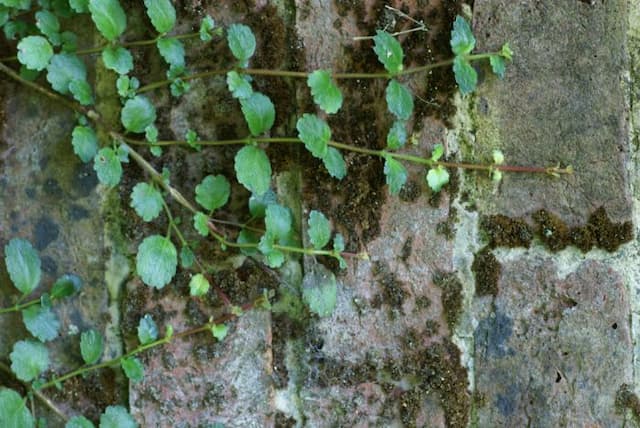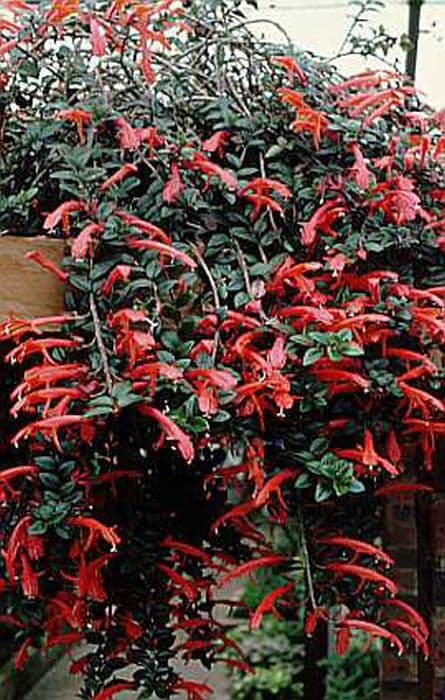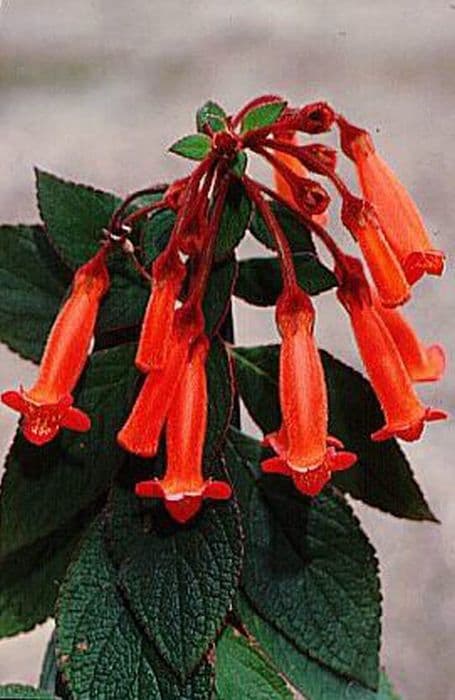Goldfish Plant Nematanthus 'Black Magic'

ABOUT
Nematanthus 'Black Magic' is recognized for its unique and attractive foliage and flowers. The leaves of this plant are glossy and fleshy, presenting a deep green color that can appear almost black in certain lighting conditions. The foliage typically has an oval shape, with a succulent texture that reflects its ability to retain water and tolerate periods of dryness. Adding to its ornamental charm, the Black Magic produces bright, tubular flowers that hang downwards like small, colorful baubles. The blooms are typically a vivid orange-red or gold hue, creating a stark and pleasing contrast with the dark foliage. The flowers often have a pouch-like shape, reminiscent of goldfish, which is why the plant may sometimes be referred to as the goldfish plant. These blossoms can appear throughout the year but are most abundant during the warmer months. The overall growth habit of Nematanthus 'Black Magic' is trailing or spreading, making it an excellent choice for hanging baskets or as a spiller plant in mixed containers. The stems are somewhat wiry and may develop a trailing nature as they mature, contributing to the plant's cascading effect. The plant exudes a tropical vibe and is commonly grown indoors as a houseplant due to its decorative appearance and its preference for warm environments.
About this plant
 Names
NamesFamily
Gesneriaceae
Synonyms
Goldfish Plant
Common names
Nematanthus 'Black Magic'.
 Toxicity
ToxicityTo humans
Nematanthus 'Black Magic', commonly known as Guppy Plant, does not have well-documented toxicity to humans. However, as with many houseplants, it is generally recommended that any part of the plant not be ingested. While there is no specific information on the Guppy Plant causing toxicity in humans, consuming plant material can sometimes lead to gastrointestinal discomfort, nausea, vomiting, or diarrhea due to the presence of saponins or other irritants. If ingestion occurs, medical advice should be sought, especially if symptoms manifest.
To pets
Guppy Plant is not known to be toxic to pets. There is limited information on this specific variety, Nematanthus 'Black Magic', but the genus Nematanthus does not typically appear on lists of plants that are poisonous to pets. Nevertheless, ingestion of plant material by pets, especially cats and dogs, could potentially lead to mild gastrointestinal upset, including vomiting or diarrhea. It is always a good practice to prevent pets from chewing on any houseplants, as individual animals might have unique sensitivities. If a pet ingests part of a Guppy Plant and exhibits symptoms, it is advisable to contact a veterinarian.
 Characteristics
CharacteristicsLife cycle
Perennials
Foliage type
Evergreen
Color of leaves
Green
Flower color
Red
Height
1-2 feet (30-60 cm)
Spread
1-2 feet (30-60 cm)
Plant type
Shrub
Hardiness zones
11
Native area
Brazil
Benefits
 General Benefits
General Benefits- Easy to care for: The Goldfish Plant is known for being low maintenance and easy to grow, making it suitable for gardeners of all levels.
- Attractive foliage: It exhibits glossy green leaves that can add a lush appearance to indoor spaces.
- Unique blooms: The Goldfish Plant is valued for its distinctive, fish-shaped orange flowers that can add a splash of color to your home or garden.
- Long blooming period: It typically has a long flowering season, which can bring extended periods of visual interest.
- Compact growth: With its compact size, it’s ideal for smaller spaces and can be grown in hanging baskets or pots.
- Humidity loving: The Goldfish Plant thrives in humid conditions, which can be beneficial if you’re looking to increase the humidity in your home.
 Medical Properties
Medical PropertiesThis plant is not used for medical purposes.
 Air-purifying Qualities
Air-purifying QualitiesThis plant is not specifically known for air purifying qualities.
 Other Uses
Other Uses- Nematanthus 'Black Magic', also known as Goldfish Plant, can be used as a conversation starter for its unique pouch-like blooms that resemble tiny goldfish.
- The plant’s trailing habit makes it an exceptional choice for creating living jewelry such as living necklaces or earrings when miniaturized.
- With its ability to bloom in low light, the Goldfish Plant can be used as a natural decoration in dimly lit restaurants or cafes to add a pop of color.
- It can serve as a teaching tool in schools for lessons on plant care and propagation, illustrating how to grow plants from stem cuttings.
- Goldfish Plant’s rich green foliage and bright orange flowers can be used in terrariums to mimic a miniature tropical forest environment.
- Its unusual flowers can be a source of inspiration for artists and designers, particularly in textile and pattern design.
- This plant can be used in thematic gardens, such as pet-themed gardens, due to its flowers’ resemblance to fish.
- Small vases with cuttings of the Goldfish Plant can be used as unique, living table centerpieces for events or weddings.
- The plant can act as a natural humidifier in small spaces when grouped in large numbers due to its tropical nature and preference for high humidity.
- Used as an educational tool in photography classes, the Goldfish Plant provides students with a vibrant subject to practice macro and close-up photography.
Interesting Facts
 Feng Shui
Feng ShuiThe Goldfish Plant is not used in Feng Shui practice.
 Zodiac Sign Compitability
Zodiac Sign CompitabilityThe Goldfish Plant is not used in astrology practice.
 Plant Symbolism
Plant Symbolism- Mystery: The 'Black Magic' attribute in the name suggests an element of the unknown and mystical, often associated with the color black and the esoteric or supernatural aspects it symbolizes.
- Beauty: As a visually striking plant, Nematanthus 'Black Magic' symbolizes the allure and aesthetic pleasure that plants can provide through their unique appearance.
- Resilience: Being a houseplant that can thrive under indoor conditions, it represents the ability to adapt and flourish in various environments.
 Water
WaterThe Goldfish Plant should be watered regularly, allowing the soil to dry slightly between waterings. Water the plant deeply, using enough water so that it runs through the drainage holes of the pot—typically around 8 to 16 ounces for a standard pot size every week or so, depending on the environment. In the winter, reduce watering frequency to every other week. Make sure not to let the plant sit in water as this can lead to root rot. It's essential to use a well-draining potting mix to prevent water from accumulating at the bottom of the pot.
 Light
LightGoldfish Plant thrives in bright, indirect light away from direct sunlight, which can burn the leaves. A spot with filtered light, such as near a north or east-facing window, is ideal. If the plant does not receive enough light, its blooms may be inhibited, so ensuring adequate light is key for flowering.
 Temperature
TemperatureGoldfish Plant prefers warm conditions, thriving in temperatures between 65 and 80 degrees Fahrenheit. It should not be exposed to temperatures below 50 degrees Fahrenheit, as cold drafts can damage the plant. Ideal growth occurs when room temperatures are consistently maintained in the aforementioned range.
 Pruning
PruningPrune the Goldfish Plant to maintain its shape and encourage bushier growth. Pruning is best done in the spring before the new growth starts. Trim back leggy stems and remove any dead or yellowing leaves to promote the health of the plant. Pinching off the tips of the stems can also stimulate more branching and flowering.
 Cleaning
CleaningAs needed
 Soil
SoilGoldfish plant prefers well-draining soil rich in organic matter with a soil pH of 6.1 - 6.5. A mix of peat, pine bark, and perlite in equal parts can work well, providing both aeration and moisture retention.
 Repotting
RepottingGoldfish plant should ideally be repotted every one to two years to refresh the soil and encourage growth. Use a slightly larger pot each time to give the roots more room.
 Humidity & Misting
Humidity & MistingGoldfish plant thrives in high humidity levels around 60-80%. It's essential to maintain these levels for optimal growth and health, especially during dry winter months.
 Suitable locations
Suitable locationsIndoor
Place Goldfish plant in bright, indirect light and keep soil moist.
Outdoor
Grow in shade or partial sun, protect from strong winds and frost.
Hardiness zone
10-11 USDA
 Life cycle
Life cycleNematanthus 'Black Magic', commonly known as "Black Goldfish Plant," begins its life as a seed, which, when sown in a well-draining soil mix and provided with warmth, will germinate. Emerging as seedlings, the plants display their characteristic thick, glossy leaves and begin to develop a bushy form. As the plant matures, it develops its distinctive arching branches and may start to flower, producing the striking black and gold blooms that resemble tiny goldfish, hence its common name. After flowering, if the flowers are pollinated, the plant may produce small berries containing seeds, which can start a new generation if dispersed. Throughout its life, the Black Goldfish Plant requires bright, indirect light and regular watering, but it is intolerant of overwatering and can suffer from root rot if left in soggy soil. After several years, the plant may become leggy and require pruning to encourage fuller growth and maintain its attractive appearance.
 Propogation
PropogationPropogation time
Spring-Early Summer
Propogation: Nematanthus 'Black Magic', commonly known as Guppy Plant, is best propagated during the spring or early summer when the plant is actively growing. The most popular method of propagation for this plant is through stem cuttings. To propagate the Guppy Plant using stem cuttings, a healthy, non-flowering stem of about 4 to 6 inches (10 to 15 centimeters) long is chosen. The lower leaves are removed, and the cut end can be dipped in rooting hormone powder to encourage root development. This cutting is then placed in a well-draining potting mix or directly into water. If using potting mix, maintain consistent moisture and place the pot in a warm area with bright, indirect light. Roots typically develop within a few weeks, after which the new plant can be potted up separately once it has established a robust root system.









